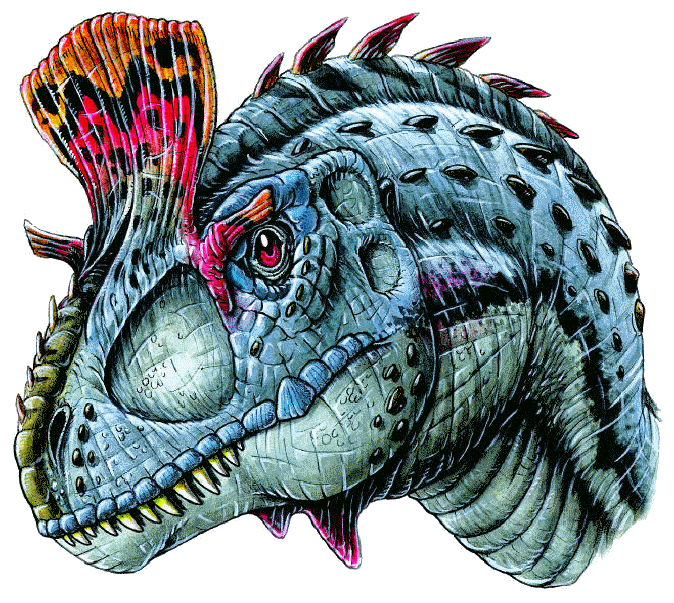|
Cryolophosaurus ellioti
(Hammer and Hickerson, 1994, 2003) |
|
 |
|
Name Means: |
"Frozen Crested Lizard" |
Length: |
20 ft. (6 m) |
|
Pronounced: |
Cry-o-Lof-o-Saw-rus |
Weight: |
unknown |
|
When it lived: |
Early Jurassic - 190 MYA |
|
|
|
Where found: |
Antarctica |
|
|
|
Cryolophosaurus is the first meat-eating dinosaur
to be discovered on the frozen continent of Antarctica. It was an odd
looking dinosaur, fairly large for such an early hunter. It had a
bizarre crest running across its head, just over the eyes, where it
rises up, perpendicular to the skull, and fans out. It is furrowed,
making it look like a Spanish comb, used by women in their hair. The
crest is actually an extension of the skull bones which lie near the
tear ducts fused on either side to horns which rise from the eye
sockets. While other theropods like the
Monolophosaurus have crests, they usually run along the
skull instead of across it. Due to its resemblance to Elvis
Presley's pompadour haircut in the 1950s, this dinosaur was quickly
nicknamed the Elvisaurus. The crest is too fragile to be used
in combat, so it was probably used in mating displays.
It is an
important discovery not only because of where it was found, but also
because it shows features found on both early, less advance
meat-eaters and later more advanced meat-eaters such as
Allosaurus. Cryolophosaurus was much smaller than the
largest
Allosaurus, which reached up to 12 meters (40 feet) in length.
Cryolophosaurus was discovered in 1991 by
paleontologist William R. Hammer and his team on Mount Kirkpatrick,
the highest peak in the Queen Alexandra Range of the Transantarctic
Mountains, and additional remains were excavated during a second
expedition in 2003. They were located in the siltstone of the Falla
Formation, and dated to the Pliensbachian age of the early Jurassic.
Hammer is a professor of geology and paleontology at Augustana College
in Rock Island, Illinois, and a curator at the Fryxell Geology Museum,
where the
holotype specimen currently resides.
The remains include part of a skull (cranium),
a jaw bone (mandible),
parts of the backbone (30
vertebrae), hip bones (the illium, ischium, and pubis), leg bones
(femur
and
fibula), an ankle bone (tibiotarsus), and foot bones (metatarsals).
The skull was partially crushed by the
Beardmore Glacier. At least the skull and jaw bone, and the foot
bones, were found in their natural positions (articulated). "Cryolophosaurus is of
significance because it represents the oldest known tetanuran from
any continent and it is the only one, from the Early Jurassic."
said Hammer. The specimen was found in conjunction with a platter from
the prosauropod which has led to speculation that it may have choked
to death, though there is no concrete evidence of this one way or the
other.
In December 2003, while
Hammer and his colleagues were continuing excavation of the
Cryolophosaurus ellioti specimen they found in 1991, their
mountain safety guide stumbled upon a sauropod dinosaur. It may turn
out to be the largest dinosaur ever found in Antarctica. It was
shipped back to the U.S. for study.
Dinosaur hunting in the polar regions is strenuous and
expensive work, especially in Antarctica, where Hammer and his
colleagues endure temperatures that regularly dip to -25 degrees
Fahrenheit (-32 Celsius), live in tents, and melt ice for drinking
water. "The sites are very inaccessible. We are 500 miles [800
kilometers] inland from the coast and about 400 miles [640 kilometers]
from the geographic South Pole," Hammer said. "They are also at high
altitude—the dino locality on Mount Kirkpatrick [where we found the
sauropod] is at about 13,000 feet [4,000 meters]."
The newly-discovered dinosaur was formally named and described in 1994 by
Hammer and William J. Hickerson, in the journal Science. The
name Cryolophosaurus was derived from the Greek kryos
(meaning "cold" or "frozen"), lophos (meaning "crest") and
sauros (meaning "lizard" or "reptile"). The name is a reference
not to the extreme conditions faced by the excavation team, but to the
relatively cool climate in which the dinosaur lived.
When this dinosaur was roaming around on
Antarctica, that island continent was a part of Pangaea and attached
to Africa, South America and Australia in a much warmer part of the
world. It is possible that Cryolophosaurus will be assigned
to the
ceratosaur family once further study is concluded. Little is
known of this dinosaur due in part to the inhospitable environment
where its remains were discovered. It is likely an important piece of
the puzzle for theropod evolution, bridging both primitive and more
advanced features.
|
|
|
|
|
|
|
|
|
Edugraphics.Net | Feenixx Publishing |
|
|
|
|